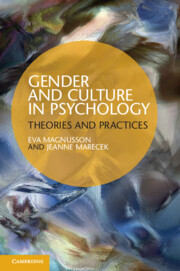Book contents
- Frontmatter
- Contents
- Preface
- 1 Gender and culture in psychology: a prologue
- 2 Categories and social categorization
- 3 Laying the foundation
- 4 Theories of gender in psychology: an overview
- 5 A turn to interpretation
- 6 Doing interpretative psychological research
- 7 Discursive approaches to studying gender and culture
- 8 Gender and culture in children's identity development
- 9 Identity and inequality in heterosexual couples
- 10 Coercion, violence, and consent in heterosexual encounters
- 11 Women's eating problems and the cultural meanings of body size
- 12 Psychological suffering in social and cultural context
- 13 Feminism and gender in psychotherapy
- 14 Comparing women and men: a retrospective on sex-difference research
- 15 Psychology's place in society, and society's place in psychology
- References
- Index
14 - Comparing women and men: a retrospective on sex-difference research
Published online by Cambridge University Press: 05 June 2012
- Frontmatter
- Contents
- Preface
- 1 Gender and culture in psychology: a prologue
- 2 Categories and social categorization
- 3 Laying the foundation
- 4 Theories of gender in psychology: an overview
- 5 A turn to interpretation
- 6 Doing interpretative psychological research
- 7 Discursive approaches to studying gender and culture
- 8 Gender and culture in children's identity development
- 9 Identity and inequality in heterosexual couples
- 10 Coercion, violence, and consent in heterosexual encounters
- 11 Women's eating problems and the cultural meanings of body size
- 12 Psychological suffering in social and cultural context
- 13 Feminism and gender in psychotherapy
- 14 Comparing women and men: a retrospective on sex-difference research
- 15 Psychology's place in society, and society's place in psychology
- References
- Index
Summary
Conversations about gender and psychology, casual conversations as well as scholarly debates, often begin with the question “What are the real differences between women and men?” We believe this question begs many questions that are more fundamental. Research on differences between men and women, or girls and boys, has been a part of psychology since the early days of the discipline. Such research has always been a site of contention, in part because researchers have conceived of both sex and gender in many ways. Research on male–female differences has long been criticized for oversimplified conceptions of sex and gender, as well as for methodological shortcomings that cannot be remedied. Yet, research comparing men and women has not abated. A search of PsycInfo, the major electronic database of psychological research, for articles on human sex differences and gender differences (terms the field has come to use interchangeably) yielded 4,011 hits for 2009.
We begin by reviewing the history of psychology's engagement with questions about the differences between men and women. We then discuss how this history has shaped the most common research approaches to these questions. We then proceed to a summary of contemporary research about psychological differences and similarities between women and men and between boys and girls. Then we examine the critiques that have been brought to bear on such research. These critiques have addressed not only methodological difficulties but also broader conceptual limitations and epistemological concerns. Finally, we discuss the strengths and weaknesses of the reductionist explanations that are often used in studies comparing men and women.
- Type
- Chapter
- Information
- Gender and Culture in PsychologyTheories and Practices, pp. 159 - 177Publisher: Cambridge University PressPrint publication year: 2012



